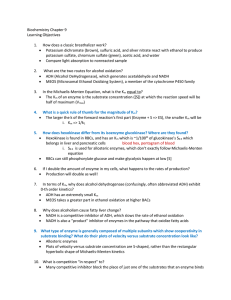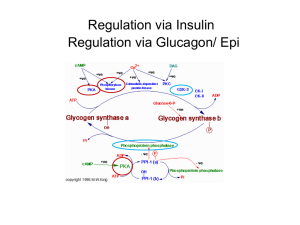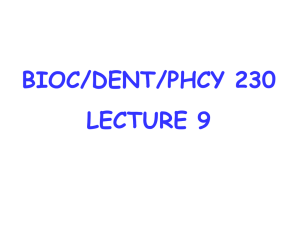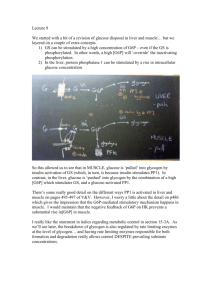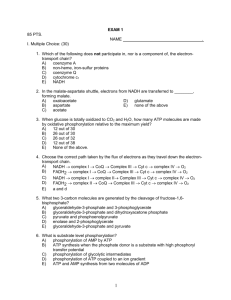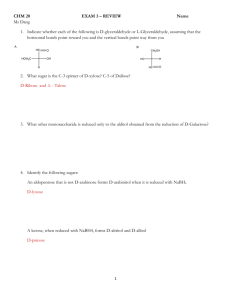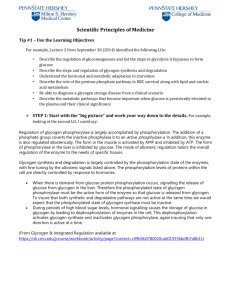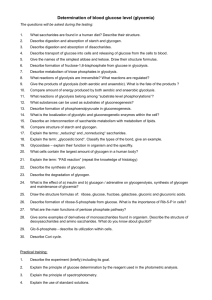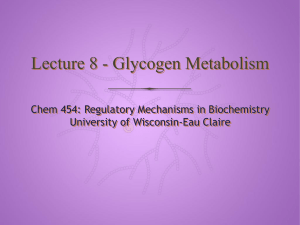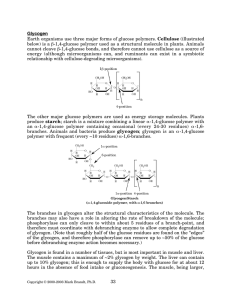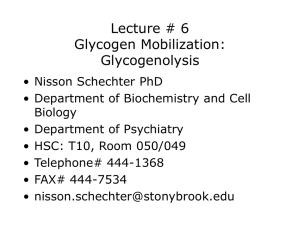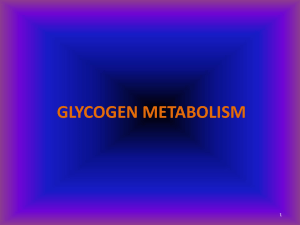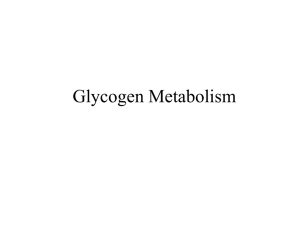File
advertisement
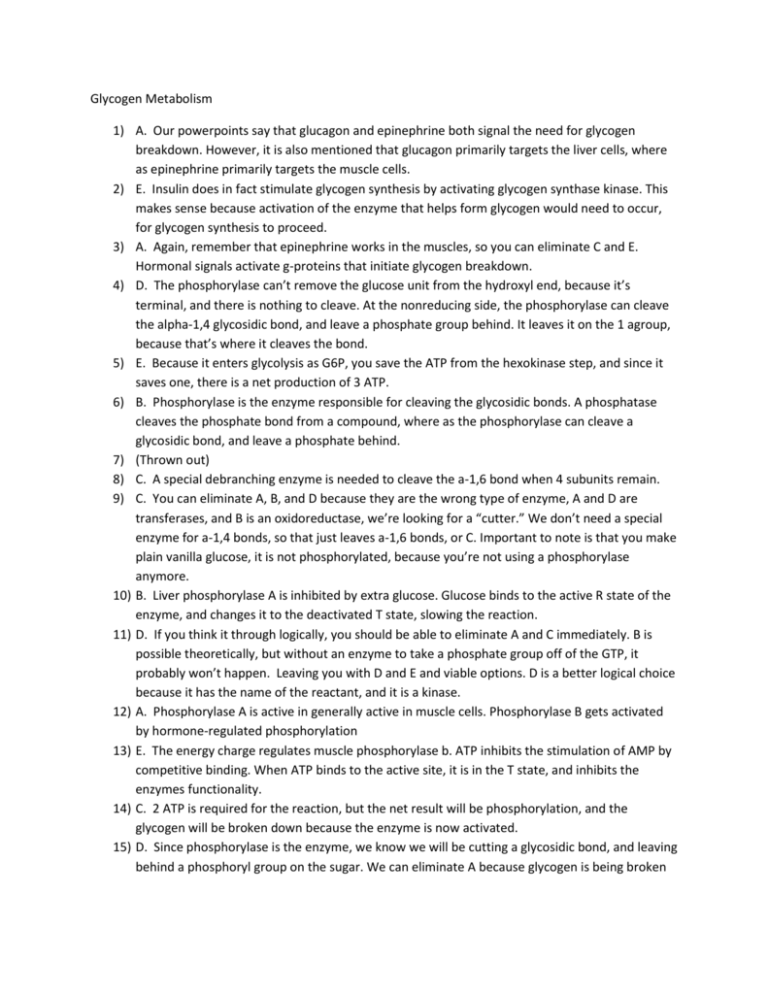
Glycogen Metabolism 1) A. Our powerpoints say that glucagon and epinephrine both signal the need for glycogen breakdown. However, it is also mentioned that glucagon primarily targets the liver cells, where as epinephrine primarily targets the muscle cells. 2) E. Insulin does in fact stimulate glycogen synthesis by activating glycogen synthase kinase. This makes sense because activation of the enzyme that helps form glycogen would need to occur, for glycogen synthesis to proceed. 3) A. Again, remember that epinephrine works in the muscles, so you can eliminate C and E. Hormonal signals activate g-proteins that initiate glycogen breakdown. 4) D. The phosphorylase can’t remove the glucose unit from the hydroxyl end, because it’s terminal, and there is nothing to cleave. At the nonreducing side, the phosphorylase can cleave the alpha-1,4 glycosidic bond, and leave a phosphate group behind. It leaves it on the 1 agroup, because that’s where it cleaves the bond. 5) E. Because it enters glycolysis as G6P, you save the ATP from the hexokinase step, and since it saves one, there is a net production of 3 ATP. 6) B. Phosphorylase is the enzyme responsible for cleaving the glycosidic bonds. A phosphatase cleaves the phosphate bond from a compound, where as the phosphorylase can cleave a glycosidic bond, and leave a phosphate behind. 7) (Thrown out) 8) C. A special debranching enzyme is needed to cleave the a-1,6 bond when 4 subunits remain. 9) C. You can eliminate A, B, and D because they are the wrong type of enzyme, A and D are transferases, and B is an oxidoreductase, we’re looking for a “cutter.” We don’t need a special enzyme for a-1,4 bonds, so that just leaves a-1,6 bonds, or C. Important to note is that you make plain vanilla glucose, it is not phosphorylated, because you’re not using a phosphorylase anymore. 10) B. Liver phosphorylase A is inhibited by extra glucose. Glucose binds to the active R state of the enzyme, and changes it to the deactivated T state, slowing the reaction. 11) D. If you think it through logically, you should be able to eliminate A and C immediately. B is possible theoretically, but without an enzyme to take a phosphate group off of the GTP, it probably won’t happen. Leaving you with D and E and viable options. D is a better logical choice because it has the name of the reactant, and it is a kinase. 12) A. Phosphorylase A is active in generally active in muscle cells. Phosphorylase B gets activated by hormone-regulated phosphorylation 13) E. The energy charge regulates muscle phosphorylase b. ATP inhibits the stimulation of AMP by competitive binding. When ATP binds to the active site, it is in the T state, and inhibits the enzymes functionality. 14) C. 2 ATP is required for the reaction, but the net result will be phosphorylation, and the glycogen will be broken down because the enzyme is now activated. 15) D. Since phosphorylase is the enzyme, we know we will be cutting a glycosidic bond, and leaving behind a phosphoryl group on the sugar. We can eliminate A because glycogen is being broken 16) 17) 18) 19) 20) 21) 22) 23) 24) 25) 26) 27) 28) 29) 30) 31) 32) 33) 34) 35) 36) down, not produced. B and C are odd choices, because we rarely talk about fructose. So logically speaking you should pick D. A. Again, think about what your given compound and target compounds are. If you phosphorylated the inactive phosphorylase b, you will activate it, and make it phosphorylase a. The enzyme that does this is phosphorylase kinase. C. PKA partially activates a hormone, and then Ca2+ fully activates it. This fully activated hormone uses ATP to phosphorylate phosphorylase-b, and activating it into phosphorylase-b. C. See answer 17. A. Synthesis of glycogen requires three steps. The first two are preparatory, and the last one is chain elongating. The first preparatory step is the synthesis of G1P from G6P by phosphoglucomutase. The second preparatory step is the synthesis of UDP-glucose from G1P by UDP-glucose phosphorylase. The third step is the synthesis of glycogen from UDP-glucose, and requires two enzymes: glycogen synthase which grows the chain, and a branching enzyme. E. Your blood glucose levels will be high after a meal, so you will want to synthesize from glycogen and store it. B. See answer 19. D. See answer 19. E. Glucose gets phosphorylated by hexokinase, and is made into G6P. G6P gets isomerized into G1P by phosphoglucomutase. A. See answer 19. D. Because glycogen has branches, it needs a specific enzyme to help with those a-1,6 bonds. E. C is not correct, because it is the opposite. Straight chains are at 1,4 linkages, and branch points are at 1,6 linkages. B. B. C. A. Hexokinase has a high glucose affinity, and is inhibited by G6P. It is nonallosteric vs. [glucose]. C. Glucokinase has a low affinity in general for glucose, so it definitely has a lower affinity than hexokinase does. B. The liver is the only thing we talked about that can act as a glucose buffer. D. Again, never really talked about fructose, not a viable option. If you have a lot of glucose, you will need to store it, so B is correct. Insulin stimulates glycogen synthesis also (don’t really know why it just does). C. A. A. Both 35 and 36 get phosphorylated, and become deactivated
